With each change of season, many take the opportunity to tune up their diets with a spring cleanse or fast. There are many types of detoxification programs and what most have in common are recommendations for a “clean” diet & supplement suggestions to support the metabolism and elimination of toxins. However, what most miss is the suggestion to decrease your exposure to toxins in the first place. If you haven’t already done so, please take our Environmental quiz and see how you score. Another article to review is: Environmental Toxins – do you know your levels. Since there are many endocrine disruptors in the environment that can block receptors of cells and interfere with cellular processes in the body, an important detoxification step in homeopathy that we prescribe is “drainage” – which helps to remove toxins in the extracellular matrix that surround organs. This step ensures that the nutrients you are taking to support health have a greater chance of being delivered to the cell. Generally, we support liver detoxification in three steps:
Step 1: homeopathic remedies to start the “drainage” or removal of toxins in the extracellular matrix
Step 2: nutritional support to help the liver get rid of these toxins and
Step 3: a herbal combination to promote better liver function.
We have five detoxification organs – our liver, kidneys, colon, lungs and skin. If the liver cannot keep up with the removal of toxins, the detoxification process spills onto the other organs and when the entire system is overburdened, symptoms appear such as skin issues (acne, eczema), asthma, headaches or digestive issues (constipation, bloating, gas, indigestion). A key step in a complete detoxification program is diet. If you are up for it, we have outlined a 3 Day Detox plan – we hope you give it a try!
3 DAY MEAL PLAN
Day 1, 2 & 3
• UPON RISING – Ginger Lemon Detox Drink
• BREAKFAST – either the Super Detox Green Juice or Super Simple Green Drink
• MID MORNING SNACK – Cucumber, Celery & Carrot Sticks
• LUNCH – Sushi Salad or green salad
• AFTERNOON SNACK – Activated almonds
• DINNER – Potassium Balance Soup
• DESSERT – Chia Pudding
• AFTER DINNER – Calming Chamomile Tea
UPON RISING: Ginger Lemon Detox Drink (Serves 1)
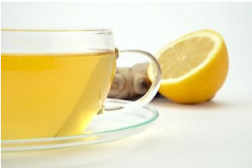 Ginger is a powerful detoxifier that helps to kick-start your metabolism. Along with hydrating your body, this drink will help to stimulate bowel movements.
Ginger is a powerful detoxifier that helps to kick-start your metabolism. Along with hydrating your body, this drink will help to stimulate bowel movements.
Drink one large glass, but you can drink more if you like – hydration is important.
• 12-ounces of room temperature spring or filtered water
• Juice of 1/2 lemon (do not put peel in water)
• ½ inch ginger root
Add the lemon juice to the glass of water. Finely grate the ginger on a chopping board, then squeeze the ginger pieces in your hand, letting the juice of the ginger drip through your fingers and into the glass of water. Enjoy at room temperature upon rising for an amazing start to the day!
BREAKFAST: Option 1: Super Detox Green Juice (Serves 1)
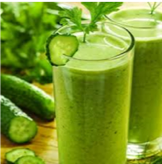
This morning juice includes a potent blend of easily digestible alkaline minerals. Alkalizing your blood is important during the cleansing process because it keeps bad bacteria, yeast and fungi in check, which decreases cravings.
Drink one large glass, but feel free to have a second. If you don’t have a juicer use a blender or magic bullet with some filtered water.
• 2 to 3 organic celery stalks, leaves removed
• 1 small organic cucumber
• 2 organic kale leaves
• Handful of fresh parsley
• 1 small lemon or lime, peeled
• 1 organic pear or organic apple
Juice all of the ingredients and sip slowly. For an extra health kick, stir in barley grass, wheatgrass, fibre/chlorella powder* and/or spirulina powder.
Option 2: Super Simple Green Drink (Serves 1)
This option is for those without a juicer or who have limited time! It is a highly alkalizing green drink, which helps to detoxify the blood. It may taste a little strange at first, but the more you drink it, the more you’ll get used to the flavor.
• 12 ounces spring or filtered water
• 1 tablespoon barley grass or wheatgrass powder
• 1 teaspoon spirulina or fibre/chlorella powder*
*Fibre/chlorella powder available at our clinic
Stir all of the ingredients together and then serve.
MID-MORNING SNACK: Cucumber, Celery And Carrot Sticks (Makes enough for 3 days)
This is your morning snack and keeps your cleanse on track. It’s easy to prepare and have when you’re on the run.
• 3 organic celery stalks, leaves removed
• 3 small organic cucumbers
• 3 small organic carrots
Wash all of the vegetables and cut them into small strips. Store in the fridge to keep them fresh and crisp.
Option: have another Super Detox Green Juice or Super Simple Green Drink.
LUNCH: Sushi Salad (Serves 1 or 2)
This salad includes a powerful mix of sprouts and sea vegetables. Sea vegetables, including nori, are nutritionally dense. They are particularly high in calcium and iodine, which helps to draw toxins from the body. If you’re at work or on the run, and have no time to prepare this salad, choose a big green vegetarian salad for lunch with an “all natural” dressing. Make sure to read ingredients; if it looks suspicious or contains sugar, ask for fresh lemon and extra-virgin olive oil on the side or forego the dressing.
For the Salad: Mix together in a bowl
• 1 ripe avocado, chopped
• 2 small organic cucumbers, halved and chopped
• 1 organic carrot, grated
• handful of organic sprouts (preferably alfalfa, watercress, or sunflower sprouts)
• handful of fresh organic cilantro, finely chopped
• 1 nori sheet, cut roughly with scissors into bite-size strips
• 1 tablespoon toasted sesame seeds
For the Dressing: Mix together in a bowl or jar. Toss on salad
• 1 tablespoon finely grated ginger root
• 1 tablespoon organic tamari sauce
• juice of 1 organic lemon
To prepare the dressing, take the ginger gratings and squeeze them between your fingers, making your hand a fist, into a small jar. Discard the pulp. Add the tamari and the lemon juice to the ginger juice. Close the lid and shake. Toss with the salad dressing and sprinkle seeds over the top to garnish.
AFTERNOON SNACK: Activated Almonds (Makes enough for 3 days)
A handful of soaked (or activated) nuts will be your afternoon snack throughout this cleanse. Plan ahead by soaking a large bowl of raw almonds overnight, straining the water away in the morning, and storing them covered in the fridge.
Why soak nuts?
-
-
- to break down phytic acid and make digestion easier
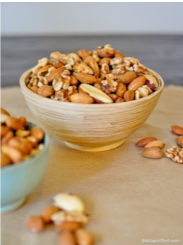
- to make the proteins more readily available for absorption
- to encourage the production of beneficial enzymes
- to help neutralize toxins in the colon and keep the colon clean
- to increase the amounts of vitamins, especially B vitamins
- 3 handfuls raw almonds (you can use a mixture of macadamia nuts, pecans, hazelnuts, Brazil nuts, pine nuts, pumpkin seeds or sunflower seeds
- Filtered or spring water at room temperature
- 1 teaspoon unrefined sea salt
In a large bowl, place all of the ingredients with enough water to cover fully. Leave at room temperature for at least 4 hours or overnight. Strain in a sieve. Store the nuts in a covered container in the fridge.
DINNER: Potassium Balance Soup (3 Servings – 1 serving per night during the detox)
Based on a recipe from physician Henry Bieler (Bieler’s Broth), this vegetable tonic provides an ideal combination for restoring acid–alkaline and sodium–potassium balance to the body’s organs and glands.
 • 4 cups spring or filtered water
• 4 cups spring or filtered water
• 4 medium organic zucchini, finely chopped
• 3 organic celery stalks, leaves removed, then finely chopped
• 1 cup roughly chopped green string beans
• 1 large bunch fresh organic parsley, stems and leaves roughly chopped
• 3 medium organic tomatoes, finely chopped
• 3 garlic cloves, finely chopped
• 2 teaspoons unrefined sea salt or 1 tablespoon organic miso paste
• 2 teaspoons dried thyme, rosemary, oregano, or other French Provence herbs for added flavour
Put all of the ingredients in a large stock or sauté pot. Bring to a boil, then lower the heat, cover, and let simmer for 30 minutes. Serve warm. If you wish to create a thicker soup, you can purée the soup in batches in a blender until smooth or creamy; however, this soup is also delicious as is. Store covered in the fridge for use within one week or freeze for extended storage.
DESSERT: Chia Seed Pudding (3 Servings – 1 serving per night during the detox)
This after-dinner snack includes chia seeds, a gelatinous plant food that helps detoxification. Chia seeds are also high in omega-3’s and make you feel full and satiated!
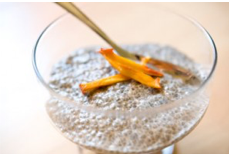 • 1 ¼ c nut or coconut milk (either store bought or homemade) – homemade nut milk recipes below
• 1 ¼ c nut or coconut milk (either store bought or homemade) – homemade nut milk recipes below
• 1 tablespoon raw honey or maple syrup
• 4 tablespoons chia seeds
• 1 teaspoon ground cinnamon
In a large jar, combine all of the ingredients and shake well. Pour the mixture into 3 small bowls or glasses and refrigerate until it thickens into a pudding-like consistency, about 30 minutes. This is a delicious treat and keeps for up to a week covered in the fridge.
Almond milk (serves 1)
• ½ c raw almonds
• 1 tablespoon honey or brown rice syrup
• 1 cup water
Combine almonds, honey and ½ c water in blender. Slowly add remaining water and blend until creamy. If you like a thinner milk, add 1 to 3 ounces more water.
AFTER DINNER: Calming Chamomile Tea (Serves 1)
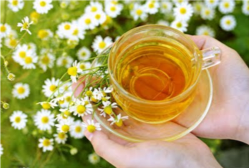
Chamomile tea will help to calm your body and prepare you for a restful night’s sleep. Deep restful sleep during this cleanse is important because of how it will help you digest unwanted stress hormones, which can cause you to gain weight.
• 1 cup spring or filtered water
• 1 chamomile tea bag or 1 tablespoon dried chamomile flowers
Bring the water to a boil and pour into a teacup or mug. Add the tea bag or, if using loose flowers, use a teapot and a strainer. Steep for 3 to 5 minutes, then enjoy.
Optionally, try other herbal detox teas, such as nettle, dandelion root, or licorice root. We recommend teas by Dragonfly Organics, www.dragonfly-organics.com
SHOPPING GUIDE – PREPARING FOR THE 3 DAY DETOX
Grocery List
For the detox, you will need to first select which breakfast you would like…
Super Detox Green Juice
- Organic celery stalks (4-6 stalks)
- Organic cucumber (3 Small)
- Organic kale leaves (6 leaves)
- A handful of fresh parsley
- Lemon or lime (3 small)
- Organic pear or organic apple (3)
|
OR |
Super Simple Green Drink
- Barley grass or wheatgrass powder (3 tablespoons)
- Spirulina powder (3 teaspoons)
|
Once you have selected which breakfast you would like, add that shopping list to the following list.
- Filtered or spring water
- Lemon (6)
- Organic Celery Stalks (6 Organic)
- Organic Cucumbers (10 small)
- Organic carrots (6 small)
- Organic tomatoes (3 medium)
- Organic zucchini (4 medium)
- Green string beans (1 cup)
- Avocado (3 ripe)
- Organic sprouts, preferably alfalfa, watercress, or sunflower sprouts (3 handfuls)
- Garlic cloves (3 cloves)
- Ginger (3 knobs)
- Fresh organic cilantro, finely chopped (3 handfuls)
- Dried thyme, rosemary, oregano, or other French Provence herbs (2 teaspoons)
- Fresh organic parsley (1 large bunch)
- Ground cinnamon (1 tsp)
- Nori sheets (3)
- Tamari or soy sauce (3 tablespoons)
- Organic miso paste (1 tablespoon) or Unrefined sea salt (2 teaspoons)
- Raw almonds (you can use almonds or a mixture of macadamia nuts, pecans, hazelnuts, Brazil nuts, pine nuts, pumpkin seeds or sunflower seeds) (3 handfuls)
- Toasted sesame seeds (3 tablespoons)
- Unrefined sea salt (1 teaspoon)
- Raw honey or maple syrup (1 tbsp)
- Chia seeds (4 tbsp)
- Homemade Nut Milk or Homemade Coconut Milk, or if you do not have time, use store-bought almond or hemp milk
-
- Raw almonds (1.5 cups)
- Honey or rice syrup (3 tbsp)
- Chamomile Tea / Dried Chamomile Flowers
Note: If a listed ingredient is not in season or available where you live, substitute something similar.
WHAT YOU CAN EXPECT DURING AND AFTER THE DETOX:
After the detox, you’ll likely come away with increased energy, improved mental clarity glowing skin, weight loss, increased immunity, and a renewed passion for life.
We recommend doing this detox twice a year in the Spring and Fall. If you’re feeling more adventurous or want to experience even better results, extend the detox to seven or ten days and add in some of the healthy lifestyle suggestions listed below. If you haven’t done a detox before and are unsure what to expect, you might want to start the program on a Friday and complete the detox over the weekend.
Some people may feel energized, others may want to rest; but either way, it’s about listening to your body. Some people may experience mild detox symptoms, which include headaches, tiredness, irritability, and mucus elimination. These are all normal symptoms and a sign that your body is beginning to cleanse.
Reference/Sourced from: Hungry For Change by: James Colquhoun and Laurentine Ten Bosch, Harper Collins 2012
 Ginger is a powerful detoxifier that helps to kick-start your metabolism. Along with hydrating your body, this drink will help to stimulate bowel movements.
Ginger is a powerful detoxifier that helps to kick-start your metabolism. Along with hydrating your body, this drink will help to stimulate bowel movements.

 • 4 cups spring or filtered water
• 4 cups spring or filtered water • 1 ¼ c nut or coconut milk (either store bought or homemade) – homemade nut milk recipes below
• 1 ¼ c nut or coconut milk (either store bought or homemade) – homemade nut milk recipes below
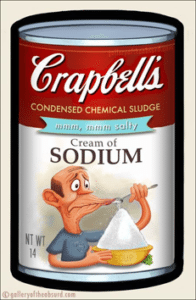 Salt is a mineral that is needed in small amounts by our cells (ie 1 g per day). The problem with processed foods is that salt is often used in higher amounts to enhance flavour. In this soup can there is over 730mg– almost enough for your entire daily allowance. Canadians eat about 3400 mg of sodium each day – more than double the amount we need. The problem with salt is that it can increase blood pressure. High blood pressure is a major factor in stroke and heart disease, one of the leading causes of death in Canada. There is also increasing evidence of links between high salt intake and stomach cancer, osteoporosis, obesity, kidney stones, kidney disease, vascular dementia and water retention. Salt can also exacerbate the symptoms of asthma, Ménière’s disease and diabetes5,6
Salt is a mineral that is needed in small amounts by our cells (ie 1 g per day). The problem with processed foods is that salt is often used in higher amounts to enhance flavour. In this soup can there is over 730mg– almost enough for your entire daily allowance. Canadians eat about 3400 mg of sodium each day – more than double the amount we need. The problem with salt is that it can increase blood pressure. High blood pressure is a major factor in stroke and heart disease, one of the leading causes of death in Canada. There is also increasing evidence of links between high salt intake and stomach cancer, osteoporosis, obesity, kidney stones, kidney disease, vascular dementia and water retention. Salt can also exacerbate the symptoms of asthma, Ménière’s disease and diabetes5,6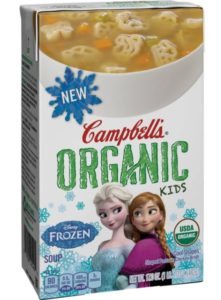 Campbell’s itself has recognized the need for an overhaul of its ingredients and this year has introduced a line of organic soups. These are made with whole organic vegent-tables and sold in tetra-pack containers with no BPA. Campbell’s CEO Denise Morrison applauded consumers, “They want to know what ingredients are used in their food and where they come from”1
Campbell’s itself has recognized the need for an overhaul of its ingredients and this year has introduced a line of organic soups. These are made with whole organic vegent-tables and sold in tetra-pack containers with no BPA. Campbell’s CEO Denise Morrison applauded consumers, “They want to know what ingredients are used in their food and where they come from”1